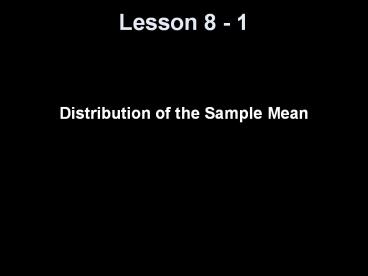Distribution%20of%20the%20Sample%20Mean - PowerPoint PPT Presentation
Title:
Distribution%20of%20the%20Sample%20Mean
Description:
Lesson 8 - 1 Distribution of the Sample Mean Objectives Understand the concept of a sampling distribution Describe the distribution of the sample mean for sample ... – PowerPoint PPT presentation
Number of Views:156
Avg rating:3.0/5.0
Title: Distribution%20of%20the%20Sample%20Mean
1
Lesson 8 - 1
- Distribution of the Sample Mean
2
Objectives
- Understand the concept of a sampling distribution
- Describe the distribution of the sample mean for
sample obtained from normal populations - Describe the distribution of the sample mean from
samples obtained from a population that is not
normal
3
Vocabulary
- Statistical inference using information from a
sample to draw conclusions about a population - Standard error of the mean standard deviation
of the sampling distribution of x-bar
4
Conclusions regarding the sampling distribution
of X-bar
- Shape normally distributed
- Center mean equal to the mean of the population
- Spread standard deviation less than the
standard deviation of the population - Law of Large numbers tells us that as n increases
the difference between the sample mean, x-bar and
the population mean µ approaches zero
5
Central Limit Theorem
X or x-barDistribution
Regardless of the shape of the population, the
sampling distribution of x-bar becomes
approximately normal as the sample size n
increases. Caution only applies to shape and
not to the mean or standard deviation
Random Samples Drawn from Population
Population Distribution
6
Summary of Distribution of x
Shape, Center and Spread of Population Distribution of the Sample Mean Distribution of the Sample Mean Distribution of the Sample Mean
Shape, Center and Spread of Population Shape Center Spread
Normal with mean, µ and standard deviation, s Regardless of sample size, n, distribution of x-bar is normal µx-bar µ s sx-bar ------- ?n
Population is not normal with mean, µ and standard deviation, s As sample size, n, increases, the distribution of x-bar becomes approximately normal µx-bar µ s sx-bar ------- ?n
7
What Happens to Sample Spread
- If the random variable X has a normal
distribution with a mean of 20 and a standard
deviation of 12 - If we choose samples of size n 4, then the
sample mean will have a normal distribution with
a mean of 20 and a standard deviation of 6 - If we choose samples of size n 9, then the
sample mean will have a normal distribution with
a mean of 20 and a standard deviation of 4
8
Example 1
- The height of all 3-year-old females is
approximately normally distributed with µ 38.72
inches and s 3.17 inches. Compute the
probability that a simple random sample of size n
10 results in a sample mean greater than 40
inches.
P(x-bar gt 40)
µ 38.72 s 3.17 n 10
sx 3.17 / ?10 1.00244
x - µ Z ------------- sx
1.28 ----------------- 1.00244
40 38.72 ----------------- 1.00244
1.277
normalcdf(1.277,E99) 0.1008 normalcdf(40,E99,38
.72,1.002) 0.1007
9
Example 2
- Weve been told that the average weight of
giraffes is 2400 pounds with a standard deviation
of 300 pounds. Weve measured 50 giraffes and
found that the sample mean was 2600 pounds. Is
our data consistent with what weve been told?
P(x-bar gt 2600)
µ 2400 s 300 n 50
sx 300 / ?50 42.4264
x - µ Z ------------- sx
200 ----------------- 42.4264
2600 2400 ----------------- 42.4264
4.714
normalcdf(4.714,E99) 0.000015 normalcdf(2600,E9
9,2400,42.4264) 0.0000001
10
Summary and Homework
- Summary
- The sample mean is a random variable with a
distribution called the sampling distribution - If the sample size n is sufficiently large (30 or
more is a good rule of thumb), then this
distribution is approximately normal - The mean of the sampling distribution is equal to
the mean of the population - The standard deviation of the sampling
distribution is equal to s / ?n - Homework
- pg 431 433 3, 4, 6, 7, 12, 13, 22, 29
11
Homework
- 3) standard error of the mean
- 4) zero
- 6) population is normal
- 7) four
- 12) µ64, s 18, n36 µx-bar 64, sx-bar
18/?36 18/6 3 - 13) µ64, s 18, n36 µx-bar 64, sx-bar
18/?36 18/6 3 - 22) µ81.7, s 6.9
- a) P(x lt 75) 0.1658
normalcdf(-E99,75,81.7,6.9) - b) n5 P(xlt75) 0.01496
normalcdf(-E99,75,81.7,6.9/?5) - c) n8 P(xlt75) 0.00301
normalcdf(-E99,75,81.7,6.9/?8) - d) very unlikely (or unusual)
- 29) P(x lt 45) 0.0078
normalcdf(-E99,45,50,16/?60)

